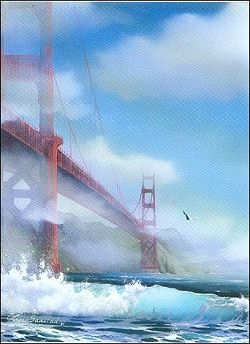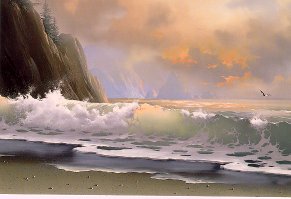Meet Marc Saastad!

"I was born down in Arkansas in a little log cabin...
OR WAS I???"
The following are excerpts from the July 2003 issue of Stitcher's World. Used by permission of
Cross-Stitch & Needlework magazine (formerly Stitcher's World). No part of this page may be copied in any form,
electronically or otherwise, without permission of Cross-Stitch & Needlework magazine and The Silver Lining.
Marc's Childhood
Marc was born and raised in the tiny coastal town of Holmestrand on the Oslo Fjord in Norway.
When he was about 7, he developed a love for drawing, and at age 13, he began painting with oils.
Because canvases weren't available near his home, Marc painted on bottles, boxes, and nearly any other
suitable surface he could find. Often, his subject matter included flowers of all different types. "I liked just about anything that had to do with color," he comments.
His love for color also drew him to needlework when he was 12 years old. His next step, at age 14, was to create his first original design, a field of wildflowers stitched on aida cloth. Although he doesn't have the chart, he still has the stitched piece.
 Marc's hometown |
 Marc's first design |
Art was a passion - and talent - that ran in his family. His grandmother, who did beautiful drawings, was a relative of Edward Munch, one of the most respected artists in Europe and Scandinavia and the artist who painted "The Scream." Although his family encouraged Marc's artistic endeavors, they didn't want him to pursue art as a career.
"I went to college for two years and didn't enjoy it very much," he recalls. "I'd heard about this great art school in Denmark and I wanted to go there, but my father said 'No way.'"
Marc's Love of the Sea
Two years after college, Marc became a cook at a local hotel. It was the beginning of his first career. While at the hotel, Marc met another cook who was a merchant seaman. "He was signing on to work on a ship, and he told me I could join him as his second cook. I though that sounded great."
In 1966, Marc joined the Norwegian Merchant Marine, and left Norway and began traveling around the world. "I learned a lot about cooking and I got to see countries I probably never would have visited otherwise," he recalls. He sailed on most of the oceans of the world, and during this time his love of the sea blossomed.
 Mark worked on the Minoru |
Marc as a Cook and Plumber!
During his time with the Merchant Marine, Marc took a vacation in the San Francisco Bay area of California. That vacation changed his life: in late 1969, he left the Merchant Marine and settled down in California, where he worked for two years as a cook for NASA at the Moffitt Field Air Base. After two years, though, he decided he had to change careers.
"My father-in-law worked as a plumber, and I took a job as a laborer with the same company. I hated it, but the pay and the benefits were better than what I could get as a cook." But as Marc was preparing to become a plumber's apprentice, the company went on strike. It was a turning point in Marc's life.
 Marc's Painting of the Golden Gate Bridge |
 Marc was a plumber! |
Marc the Artist
"I'd been painting all along, and while the strike was going on, I sold some of my paintings at weekend art shows," he recalls. Marc never went back to plumbing, but instead for the next 25 years earned a living selling his work. Over time, Marc became a sought-after artist, painting under his middle name Inge and not Marc. In San Francisco alone, the galleries sold thousands of his paintings. He has won numerous awards and is to be found in many fine publications and galleries.
His subjects were almost always ocean scenes, mainly of Western USA coastlines. Marc traveled up and down the coast, where he happily spent hours sitting on beaches and sketching while his children played. Later, he would turn the sketches into beautiful paintings to sell as original artwork and limited edition lithographs, capturing all the mysterious moods of the ever-changing oceans on canvas with oil and acrylic.
 Brooking |
 Solitude |
Marc as a Cross-stitch Designer
In 1996, Marc was rollerblading with his daughter and suffered a fall that injured his back. Traveling to art shows soon proved unbearable. "I had to think of something else I could do to earn a living."
Needlework designing seemed an obvious choice. "I was absolutely fascinated by cross stitch, so that's what I decided on," he says. "I was fascinated by color and the availability of so many colors in one medium. For me, the designing of a cross stitch project proved even more fascinating than the actual stitching."
Although most of the needlework designs Marc had created throughout his life had been flowers, the first cross stitch piece he charted and sold was, like his paintings, a seascape. Entitled "Jonathan," it was followed by two other seascapes and later, by several lighthouses from all over the US and the world.
 Jonathan |
Of course, it wasn't too long before he began designing cross stitch flowers--most of which were inspired by those found in his own resplendent garden. On just one-third of an acre, Marc has planted 40-50 different varieties of flowers, bulbs, roses, perennials, trees, and bushes. His rose garden has about 100 roses and his tulip beds are well known in the area where he lives! He has an absolute love for his flowers, and it shows in his designs, which are rendered with meticulous attention to detail. These flowers have become his inspiration for his passionate and detailed charts.
 Marc's Flowers |
 Marc's Roses |
 Marc's Flowers |
Marc's Design Process
His work always starts out as sketches on paper that, after many hours of work, end up as a possible design. Color renderings and changes take place continually and may change completely from day to day, but at a certain stage they end up getting entered into his computer. The rest of the editing, using the computer, is extremely efficient compared to the old "white-out" way of editing. That was a nightmare!
The editing goes through several stages and new colors are added or subtracted several times a day till he gets it just the way he wants it to be!
Most of Marc's patterns are designed without any fractional stitches, but he is famous for adding lots of colors, using DMC and Anchor floss, to his work. He loves colors, and DMC doesn't have enough colors for his artist's eye so he uses both DMC and Anchor in the same design. He has been called all kinds of names for that, but in the long run it's worth it because the realism of Marc's designs is unbelievable and wonderful.
 SL #001 |
 SL #172 |
Marc's Future
Marc travels all over Europe from time to time to find new ideas that will be turning into patterns, from Castles in France and Germany to gargoyles in Italy and Belgium and, of course, from the famous Bagatelle Rose Garden in Paris to the Keukenhof Gardens in Amsterdam.
In the meantime, he'll continue to split his time between designing and gardening. Marc's love for life and belief in living it to the fullest are too great to keep him down.
And the cross stitch designs? He says there are "lots more to come", including additions to his line of seascape and lighthouse designs, and more of his wonderful floral designs.

